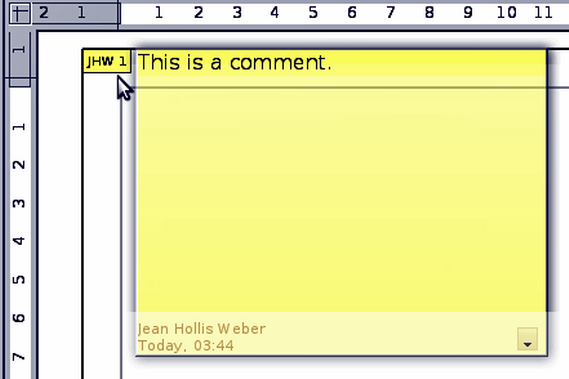

Getting Started Guide 7.0
Chapter 7
Getting Started with Draw
Vector Drawing in LibreOffice
This document is Copyright © 2020 by the LibreOffice Documentation Team. Contributors are listed below. You may distribute it and/or modify it under the terms of either the GNU General Public License (https://www.gnu.org/licenses/gpl.html), version 3 or later, or the Creative Commons Attribution License (https://creativecommons.org/licenses/by/4.0/), version 4.0 or later.
All trademarks within this guide belong to their legitimate owners.
To this edition
|
Peter Schofield |
Jean Hollis Weber |
Kees Kriek |
|
Jean Hollis Weber |
Peter Schofield |
Claire Wood |
|
Dave Barton |
Ron Faile Jr. |
Olivier Hallot |
|
Hazel Russman |
|
|
Please direct any comments or suggestions about this document to the Documentation Team’s mailing list: documentation@global.libreoffice.org
Note
Everything sent to a mailing list, including your email address and any other personal information that is written in the message, is publicly archived and cannot be deleted.
Published January 2021. Based on LibreOffice 7.0.
Some keystrokes and menu items are different on macOS from those used in Windows and Linux. The table below gives some common substitutions for the instructions in this document. For a detailed list, see the application Help.
|
Windows or Linux |
macOS equivalent |
Effect |
|
Tools > Options |
LibreOffice > Preferences |
Access setup options |
|
Right-click |
Control+click or right-click depending on computer setup |
Open a context menu |
|
Ctrl (Control) |
⌘ (Command) |
Used with other keys |
|
F11 |
⌘+T |
Open the Styles deck in the Sidebar |
LibreOffice Draw is a vector graphics drawing program, although it can also perform some operations on raster graphics (pixels). Using Draw, you can quickly create a wide variety of graphical images.
Vector graphics store and display an image as an assembly of simple geometric elements such as lines, circles, and polygons, rather than a collection of pixels (points on the screen). Vector graphics allow for easier storage and scaling of the image.
Draw is fully integrated into the LibreOffice suite, and this simplifies exchanging graphics with components of the suite. If you create an image in Draw, reusing it in a Writer document is simple. For example, select and copy the drawing in Draw and then paste the image directly into your Writer document. You can also work with drawings directly from within Writer or Impress, using a subset of the functions and tools from Draw.
The functionality of LibreOffice Draw is extensive and, even though it was not designed to rival high-end graphics applications, it possesses more functionality than the drawing tools that are generally integrated with most office productivity suites.
A few examples of the drawing functions are: layer management, magnetic grid-point system, dimensions and measurement display, connectors for making organization charts, 3D functions that enable small three-dimensional drawings to be created (with texture and lighting effects), drawing and page-style integration, and Bézier curves.
This chapter introduces some features of Draw and does not attempt to cover all of the Draw features. See the Draw Guide and LibreOffice Help for more information.
Figure 1: Draw main window
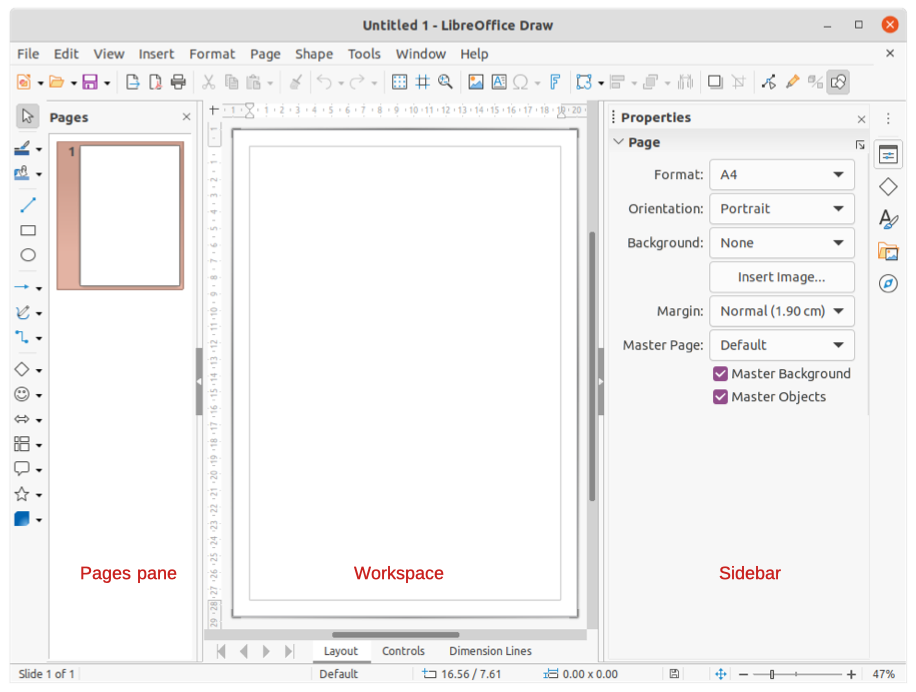
The large area in the center of the Draw main window ( Figure 1) is the Workspace, where you create drawings. This drawing area can be surrounded with toolbars and information areas. The number and position of the visible tools vary with the task in hand and user preferences.
The maximum size of a drawing page in LibreOffice Draw is limited by your computer setup and the page size that you can set and use in your printer.
In Draw, you can split drawings over several pages. Multi-page drawings are used mainly for presentations. The Pages pane, on the left side of the Draw main window, gives an overview of the pages that you create in your drawing. If the Pages pane is not visible, go to View > Page Pane on the Menu bar. To make changes to the page order, drag and drop one or more pages.
A layer is a workplace where you insert drawing elements and objects. By default, the Workspace consists of three layers (Layout, Controls, and Dimension Lines). The default layers cannot be deleted or renamed, but you can add layers when necessary.
Tabs for these layers appear in the Layers bar at the bottom of the Workspace. The Layers bar allows you to navigate between the layers and add layers as required or delete layers that you have created. For more information on layers, see “Working with layers“ below.
The Sidebar has five main decks in Draw and is similar to the Sidebar in the other LibreOffice modules. To expand a deck, click on its icon on the tab bar on the right, or click on the Sidebar Settings icon at the top of the tab bar and select a deck from the drop-down list. If the Sidebar is not visible, go to View > Sidebar on the Menu bar.
Properties
Shapes
Styles
Gallery
Navigator
You should see rulers on the upper and left-hand sides of the workspace. If they are not visible, go to View > Rulers in the Menu bar. The rulers show the size of a selected object on the page using double lines (highlighted in Figure 2). You can also use the rulers to manage object handles and guide lines when positioning objects.
The page margins in the drawing area are also represented on the rulers. You can change the margins directly on the rulers by dragging them with the mouse. The margin area is indicated by the grayed out area on the rulers as shown in Figure 2.
To change the measurement units of the rulers, right-click on a ruler and select the measurement unit from the drop down list, as shown in Figure 3 for the horizontal ruler. The horizontal and vertical rulers can be set to different measurement units.
Figure 2: Rulers showing object size
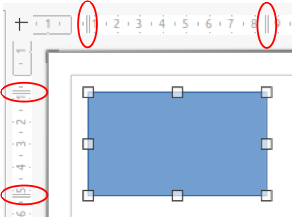
Figure 3: Ruler measurement units
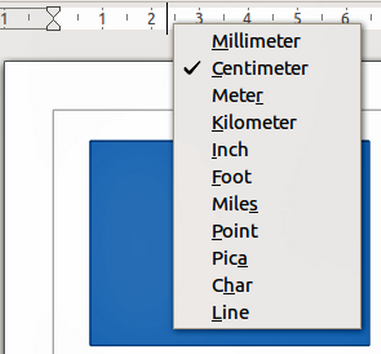
The Status Bar ( Figure 4) is located at the bottom of the Workspace in all LibreOffice modules. It includes several Draw-specific fields, which are described where relevant in this chapter. For details on the contents and use of these fields, see Chapter 1, Introducing LibreOffice, in this guide and the Draw Guide.
Figure 4: Status Bar

To hide the Status Bar, go to View on the Menu bar and deselect Status Bar.
Note
The measurement units shown on the Status Bar are set by going to Tools > Options > LibreOffice Draw > General on the Menu bar. These units may be different to the measurement units set for the rulers.
To display or hide the various toolbars used in Draw, go to View > Toolbars on the Menu bar and select which toolbars you want to display. For more information, see the Draw Guide.
The three main toolbars used in Draw are:
Standard – this toolbar is normally docked at the top of the Workspace when you open a Draw document (Figure 5).
Line and Filling – this toolbar is normally docked at the top of the Workspace below the Standard toolbar. The Line and Filling toolbar (Figure 6) only becomes active when an object on the Workspace is selected.
Drawing – this toolbar is normally docked on the left side of the Workspace and contains the tools required to draw objects in the Workspace (Figure 7).
The icons used for the tools on each toolbar depend on the computer operating system and how you have setup LibreOffice on your computer. For more information on how to setup LibreOffice, see Chapter 2, Setting Up LibreOffice.
Figure 5: Standard toolbar

Figure 6: Line and Filling toolbar

Figure 7: Drawing toolbar

Draw provides a wide range of shapes, located in palettes accessed from the Drawing toolbar or from the Shapes deck in the Sidebar (Figure 8). This section describes only a few of the basic shapes, including text, which are treated as objects in Draw. See the Draw Guide for a complete description of the basic shapes available.
Some of the icons on the Drawing toolbar will change according to the shape that has been selected. Some tools on a toolbar have extra tool palettes available and these are indicated by a small downward triangle ▼ to the right of the tool icon.
Note
When you draw a basic shape or select one for editing, the Information field in the status bar changes to reflect the present action. For example Line created, Text frame xxyy selected, and so on.
Figure 8: Shapes deck on Sidebar
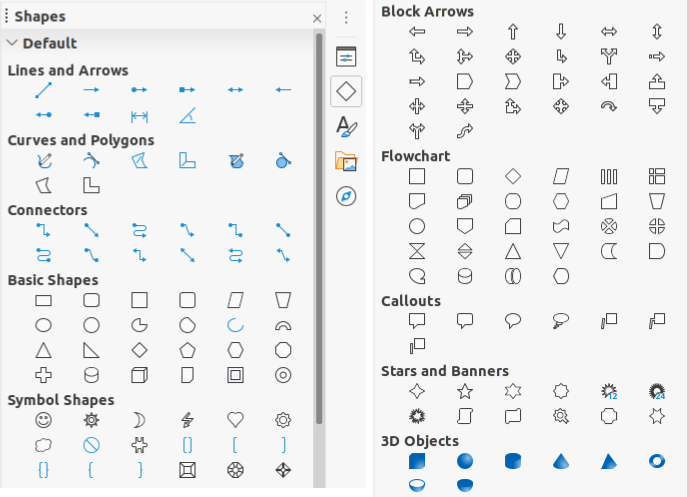
Figure 9: Line starting point
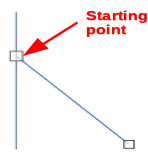
1) Use one of the following options to start drawing a line:
Click on Insert Line on the Drawing toolbar ( Figure 7).
Click the small downward triangle ▼ on the right of the Lines and Arrows tool on the Drawing toolbar and select Insert Line from the drop down list.
Click on Insert Line in the Lines and Arrows section of the Shapes deck on the Sidebar ( Figure 8).
2) Place the cursor at the point where you want to start the line and drag the mouse while keeping the mouse button pressed.
3) Release the mouse button at the point where you want to end the line. A selection handle appears at each end of the line, showing that this object is the currently selected object. The selection handle at the starting point of the line is slightly larger than the other selection handle as shown in Figure 9.
Tip
To snap the end of a line to the nearest grid point, keep the Ctrl key pressed while drawing the line. However, if the Snap to Grid option on View > Snap Guides on the Menu bar has been selected, the Ctrl key deactivates the snap to grid.
To restrict the drawing angle of a line to a multiple of 45 degrees (0, 45, 90, 135, and so on), keep the Shift key pressed while drawing the line. However, if the option When creating or moving objects in the Constrain Objects section of Tools > Options > LibreOffice Draw > Grid has been selected, the Shift key deactivates this restriction.
To draw a line symmetrically outwards in both directions from the start point, keep the Alt key pressed while drawing the line. This lets you draw lines by starting from the middle of the line.
When a line is drawn, it uses default attributes. To change any of these attributes, select the line and use one of the following methods:
Go to the Properties deck on the Sidebar and open the Line section (Figure 10).
Right-click on a line and select Line from the context menu to open the Line dialog (Figure 11).
Go to Format > Line on the Menu bar to open the Line dialog.
Use the tools Line Style, Line Width, and Line Color on the Line and Filling toolbar (Figure 6).
Figure 10: Line section in Properties deck on Sidebar
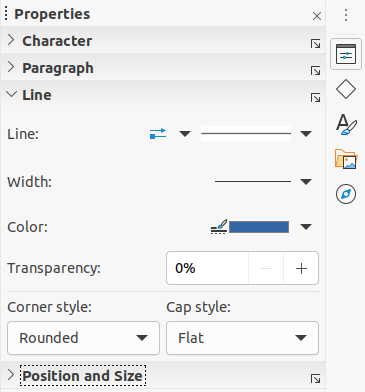
Figure 11: Line dialog
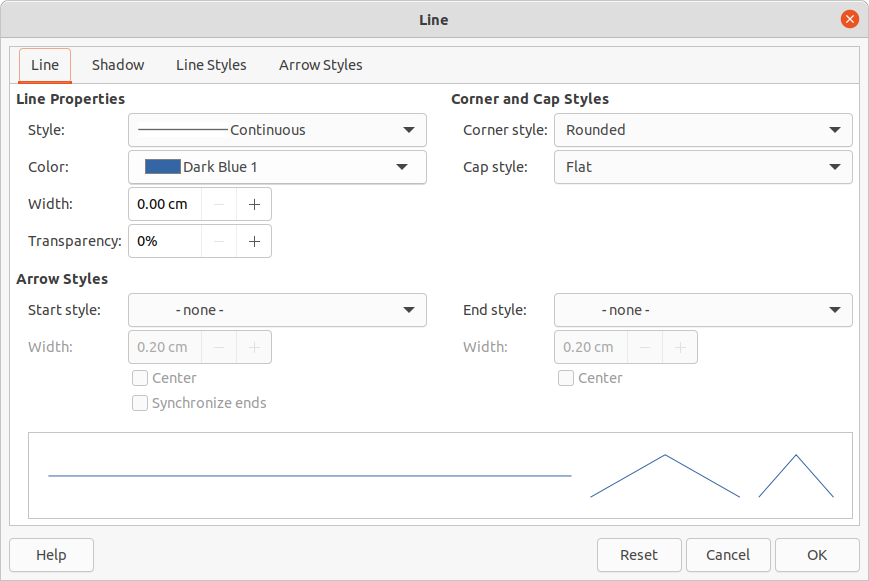
Arrows are drawn like lines. Draw classifies arrows as a subgroup of lines, that is lines with arrowheads. The information field on the Status Bar shows them only as lines.
1) Use one of the following options to start drawing an arrow:
Click the small downward triangle ▼ on the right of the Lines and Arrows tool on the Drawing toolbar ( Figure 7) and select the type of arrow you require from the sub-toolbar ( Figure 12) that opens.
Click on the type of arrow you require in the Lines and Arrows section of the Shapes deck on the Sidebar ( Figure 8).
Figure 12: Lines and Arrows
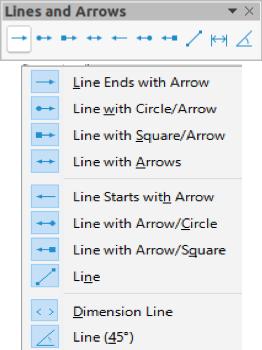
2) Place the cursor at the point where you want to start an arrow and drag the mouse while keeping the mouse button pressed. The arrowhead is drawn at the end point of the arrow when you release the mouse button.
Tip
To snap the end of an arrow to the nearest grid point, keep the Ctrl key pressed while drawing the arrow. However, if the Snap to Grid option on View > Snap Guides on the Menu bar has been selected, the Ctrl key deactivates the snap to grid.
To restrict the drawing angle of an arrow to a multiple of 45 degrees (0, 45, 90, 135, and so on), keep the Shift key pressed while drawing the arrow. However, if the option When creating or moving objects in the Constrain Objects section of Tools > Options > LibreOffice Draw > Grid has been selected, the Shift key deactivates this restriction.
To draw an arrow symmetrically outwards in both directions from the start point, keep the Alt key pressed while drawing the arrow. This lets you draw arrows by starting from the middle of the arrow.
Note
Hovering the mouse cursor over each of type of line or arrow available will tell you the type of line or arrow each tool will draw.
Note
The icon for the Lines and Arrows tool used most recently will already be selected on the Drawing toolbar. This makes it easier to use the same tool again.
Note
After drawing a line or arrow, you can change the line or arrow style by opening the Line dialog ( Figure 11) and using the options available on the Line Styles or Arrow Styles pages.
1) Use one of the following options to start drawing a rectangle:
Click on Rectangle on the Drawing toolbar ( Figure 7).
Click the small downward triangle ▼ on the right of the Basic Shapes tool on the Drawing toolbar and select Rectangle from the sub-toolbar ( Figure 13) that opens.
Click on Rectangle in the Basic Shapes section of the Shapes deck on the Sidebar ( Figure 8).
2) Place the cursor at the point where you want to start drawing the rectangle and drag the mouse while keeping the mouse button pressed. As you draw the rectangle with the mouse cursor, the rectangle appears with its bottom right corner attached to the cursor.
3) To draw a rectangle from its center, position the cursor on the drawing, press the mouse button and then hold down the Alt key while dragging the cursor. The rectangle uses the start point where you first clicked the mouse button as its center.
Figure 13: Basic Shapes
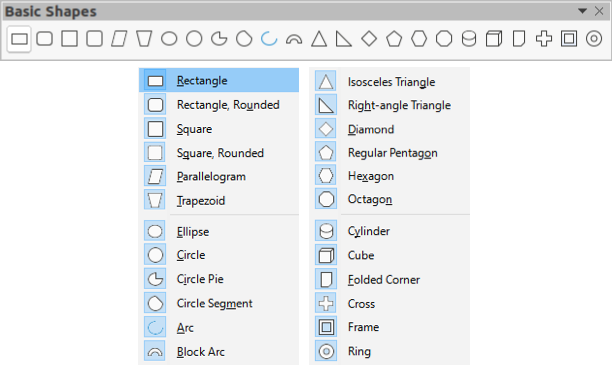
1) Use one of the following options to start drawing a square:
Click on Rectangle on the Drawing toolbar.
Click the small downward triangle ▼ on the right of the Basic Shapes tool on the Drawing toolbar and select Square from the sub-toolbar ( Figure 13) that opens.
Click on Square in the Basic Shapes section of the Shapes deck on the Sidebar.
2) Place the cursor at the point where you want to start drawing the square and drag the mouse while keeping the mouse button pressed. If you have selected the Rectangle tool, hold down the Shift key while you draw a square. As you draw the square, it appears with its bottom right corner attached to the cursor.
3) To draw a square from its center, position the cursor on the drawing, press the mouse button and then hold down the Alt key while dragging with the cursor. The square uses the start point where you first clicked the mouse button as its center.
1) Use one of the following options to start drawing an ellipse:
Click on Ellipse on the Drawing toolbar.
Click the small downward triangle ▼ on the right of the Basic Shapes tool on the Drawing toolbar and select Ellipse from the sub-toolbar ( Figure 13) that opens.
Click on Ellipse in the Basic Shapes section of the Shapes deck on the Sidebar.
2) Place the cursor at the point where you want to start drawing the ellipse and drag the mouse while keeping the mouse button pressed. As you draw the ellipse, it appears with its bottom right corner attached to the cursor.
3) To draw an ellipse from its center, position the cursor on the drawing, press the mouse button and then hold down the Alt key while dragging with the cursor. The ellipse uses the start point where you first clicked the mouse button as its center.
1) Use one of the following options to start drawing a circle:
Click on Ellipse on the Drawing toolbar.
Click the small downward triangle ▼ on the right of the Basic Shapes tool on the Drawing toolbar and select Circle from the sub-toolbar ( Figure 13) that opens.
Click on Circle in the Basic Shapes section of the Shapes deck on the Sidebar.
2) Place the cursor at the point where you want to start drawing the circle and drag the mouse while keeping the mouse button pressed. If you have selected the Ellipse tool, hold down the Shift key while you draw a circle. As you draw the circle with the mouse cursor, the circle appears with its bottom right corner attached to the cursor.
3) To draw a circle from its center, position the cursor on the drawing, press the mouse button and then hold down the Alt key while dragging with the cursor. The circle uses the start point where you first clicked the mouse button as its center.
Dimension lines display a measurement of an object in the drawing ( Figure 14). The dimension line does not belong to the object itself, but it is usually placed close to it.
1) Use one of the following options to start drawing a dimension line:
Click the small downward triangle ▼ on the right of the Lines and Arrows tool on the Drawing toolbar and select Dimension Line from the sub-toolbar that opens ( Figure 12).
Click on Dimension Line in the Lines and Arrows section of the Shapes deck on the Sidebar).
2) Place the cursor at the point where you want to start the dimension line and drag the mouse while keeping the mouse button pressed. The dimension line is drawn and automatically calculates and displays the linear dimension.
3) To change the measurement unit used for dimension lines, go to Tools > Options > LibreOffice Draw > General on the Menu bar.
4) To change the display of a dimension line and its appearance, right-click on the dimension line and select Dimensions from the context menu to open the Dimension Line dialog ( Figure 15).
5) Select the required options in Line and Legend, then click OK to save the changes and close the Line Dimension dialog.
Figure 14: Example of dimension lines
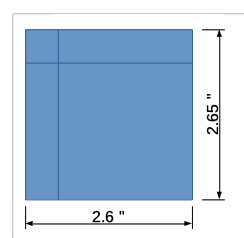
Figure 15: Dimension Line dialog
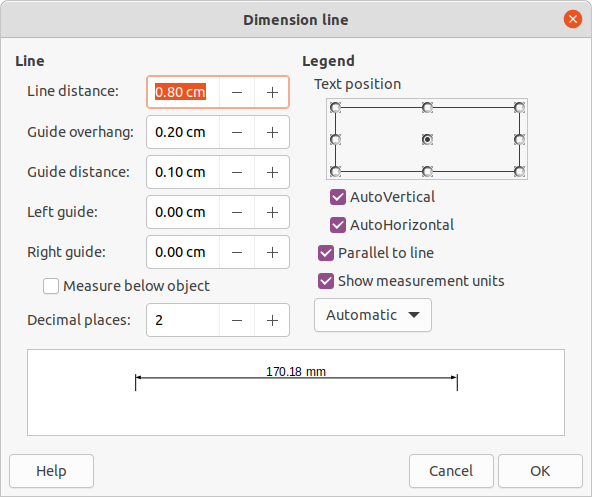
1) Use one of the following options to start drawing a curve:
Click the small downward triangle ▼ on the right of the Curves and Polygons tool on the Drawing toolbar and select the type of curve from the sub-toolbar that opens ( Figure 16).
Click on the type of curve required in the Curves and Polygons section of the Shapes deck on the Sidebar.
Figure 16: Curves and Polygons
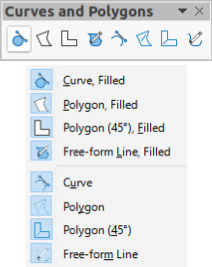
2) Click and hold the left mouse button to create the starting point of the curve, then drag from the starting point to draw a line. Release the mouse button and continue to drag the cursor to bend the line into a curve.
3) Double-click to set the end point of the curve and fix the curve on the drawing. A filled curve automatically joins the last point to the first point, closing the curve and filling it with the selected fill color. A curve without fill will not be closed at the end of drawing the curve.
Note
A single click fixes the curve to the drawing and allows you to draw straight lines from the end of the curve. Each single click allows you to continue drawing straight lines. Double click to end drawing a curve with straight lines.
1) Use one of the following options to start drawing a polygon:
Click the small downward triangle ▼ on the right of the Curves and Polygons tool on the Drawing toolbar and select the type of polygon from the sub-toolbar that opens ( Figure 16).
Click on the type of polygon required in the Curves and Polygons section of the Shapes deck on the Sidebar.
2) Click and hold the left mouse button to create the starting point of the polygon, then drag from the starting point to draw a line.
3) Release the mouse button and continue to drag the cursor to draw the next line for polygon, then click to mark the end point of the line and to start drawing another line. Holding the Shift key down while drawing lines, restricts the angles used in the polygon to 45° or 90°.
4) Double-click to set the end point of the polygon and fix the polygon on the drawing. A filled polygon automatically joins the last point to the first point, closing the polygon and filling it with the selected fill color. A polygon without fill will not be closed at the end of drawing the polygon.
A polygon 45° is drawn using the same procedure as polygons, but the angles between lines are restricted to 45° or 90°. This restriction of angles cannot be changed.
A filled polygon 45° automatically joins the last point to the first point, closing the polygon and filling it with the selected fill color.
Drawing freeform line tools is similar to drawing with a pencil on paper.
1) Use one of the following options to start drawing a freeform line:
Click the small downward triangle ▼ on the right of the Curves and Polygons tool on the Drawing toolbar and select the type of freeform line from the sub-toolbar that opens ( Figure 16).
Click on the type of freeform line required in the Curves and Polygons section of the Shapes deck on the Sidebar.
2) Click and drag the cursor to create the freeform line shape you require.
3) Release the mouse button when you are satisfied with your freeform line and the drawing is completed. A filled freeform line automatically joins the last point to the first point, closing the freeform line and filling it with the selected fill color.
All Draw objects have glue points, which are not normally displayed. Object glue points ( Figure 17) become visible on an object when a connector is selected on the Drawing toolbar or in the Shapes deck on the Sidebar.
Most objects have four glue points. You can add more standard glue points and glue points with a specific purpose using the Glue Points toolbar ( Figure 18). If the Glue Points toolbar is not visible, go to View > Toolbars > Glue Points on the Menu bar to open the toolbar. For a more detailed description on adding and using glue points, see the Draw Guide.
Glue points are not the same as the selection handles of an object. Selection handles are for moving or changing the shape of an object. Glue points are used to fix or glue a connector to an object so that when the object moves, the connector stays fixed to the object.
Figure 17: Examples of object glue points
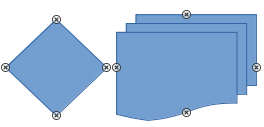
Figure 18: Glue Points toolbar
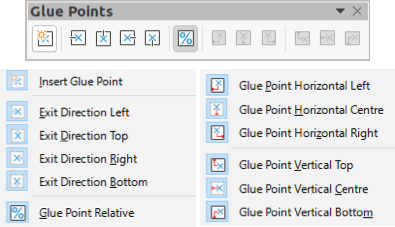
Connectors are lines or arrows whose ends automatically snap to a glue point of an object. Connectors are especially useful in drawing organization charts, flow diagrams, and mind-maps. When objects are moved or reordered, the connectors remain attached to a glue point. Figure 19 shows an example of using two objects and a connector. For a more detailed description of the use of connectors, see the Draw Guide.
Connectors can be accessed using one of the following methods:
Click the small downward triangle ▼ on the right of the Connectors tool on the Drawing toolbar and select the type of connector from the sub-toolbar that opens ( Figure 20).
Click on the type of connector required in the Connectors section of the Shapes deck on the Sidebar.
Figure 19: Example of using connectors
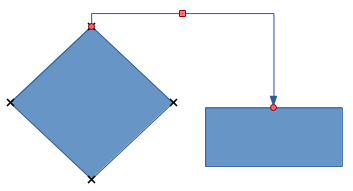
Figure 20: Connectors
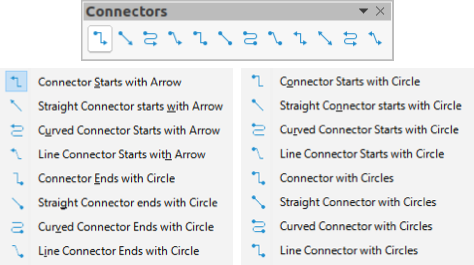
Geometric shapes are similar to basic shapes and have been provided in Draw as a starting point when creating objects for a drawing. Geometric shapes are located on the Drawing toolbar and in the Shapes deck on the Sidebar.
Access geometric shapes using one of the following methods:
Click on Shapes on the Sidebar to open the Shapes deck, then choose from the geometric shapes available ( Figure 8).
Click the small downward triangle ▼ on the right of a geometric shape on the Drawing toolbar to open a sub-toolbar giving access to more geometric shape tools. See below for the tools available.
Using geometric shapes is similar to drawing rectangles, squares, ellipses or circles as explained in “Drawing basic shapes” above. For more information on geometric shapes, see the Draw Guide.
Note
The geometric shape displayed on the Drawing toolbar is the last geometric shape selected and used to draw an object.
Note
Text can be added to all geometric shapes. For more information, see “Using text” and the Draw Guide.
Basic shapes
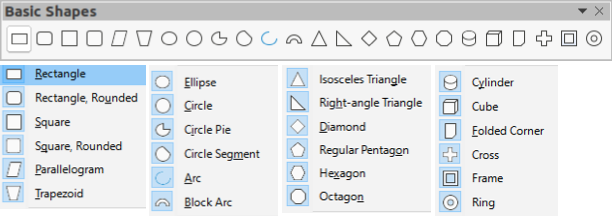
Symbol shapes
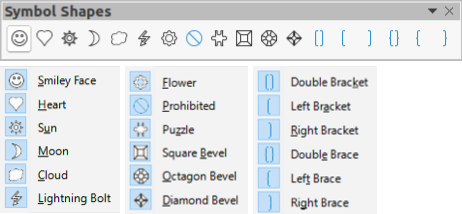
Block arrows
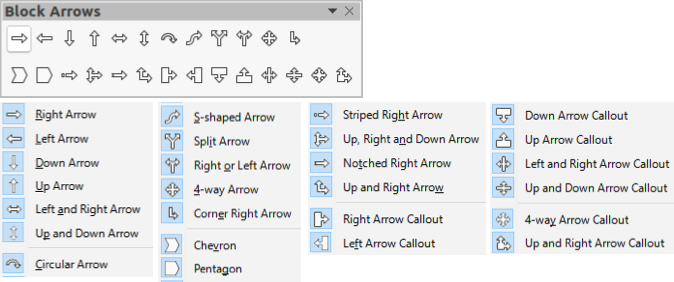
Flowchart
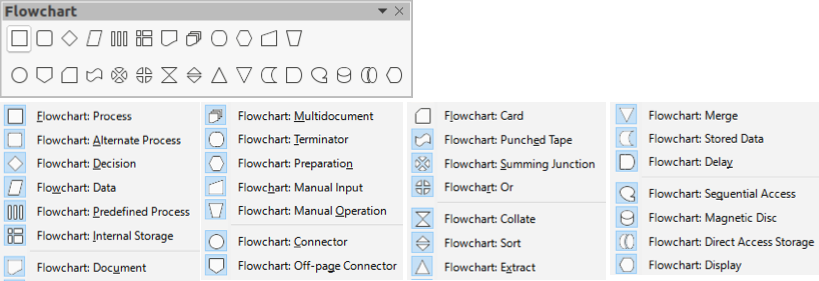
Callouts
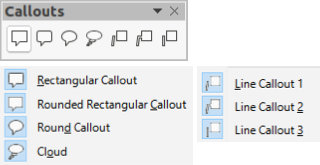
Stars and banners
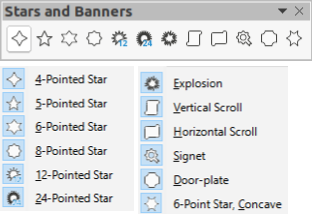
3D objects
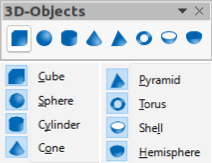
In Draw you can add, insert, and format text to a drawing, objects, and shapes as follows:
As a dynamic text frame, which is an independent Draw object and expands as you add more text within the frame.
As text within a previously drawn object. This integrates text within the object and is placed within the boundary rectangle that surrounds an object. This boundary rectangle is not dynamic and care must be taken so that your text does not go outside of the object boundaries.
For more information on how to add, insert, and format text in a drawing or drawing objects, see the Draw Guide.
Before any text can be added to a drawing, you need to activate text mode using one of the following methods:
Click on Insert Text Box on the Standard toolbar ( Figure 5).
Choose Insert > Text Box on the Menu bar.
Use the keyboard shortcut F2.
The Text Formatting toolbar ( Figure 21) automatically opens when text mode is activated, replacing the Line and Filling toolbar ( Figure 6).
Figure 21: Text Formatting toolbar

When you add text to a drawing, a text box is automatically created to contain the text.
1) Activate text mode; see “Text mode” above.
2) Create a text box in the drawing using one of the following methods:
Click at the approximate position where you want to place the text and a single line text box is created containing a flashing cursor. Start typing your text or paste copied into the text box. The width of a single line text box increases as you add text.
Click at the approximate position where you want to place the text and drag the cursor to the approximate width required for the text box creating a multi line text box. Start typing your text or paste copied into the text box. As you reach the horizontal limit of the text box, the text automatically word wraps inside the text box and the text box expands vertically as it fills.
The left corner of the Status Bar indicates that you are in text edit mode and the position of the cursor ( Figure 22).
Note
When creating single line text boxes, multiple lines of text can be created by creating a new paragraph inside the text box using the Enter key, or entering a line break in the text using Shift+Enter.
3) When you have finished typing text, click outside the text box to exit text mode. The Text Formatting toolbar closes and the Line and Filling toolbar opens in its original position.
4) To format and/or reposition the text box, see the Draw Guide for more information.
5) If required, select the text using the various tools on the Text Formatting toolbar ( Figure 21) or in the Character, Paragraph, and Lists sections in the Properties deck of the Sidebar ( Figure 23).
Figure 22: Text information on Status Bar

Figure 23: Character, Paragraph and Lists sections in Properties deck on Sidebar
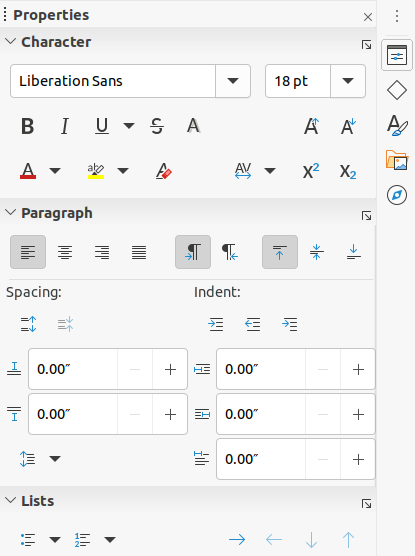
By default, Draw is set for horizontal text only. The options for vertical text have to be switched on and added as follows:
1) Go to Tools > Options > Language Settings > Languages on the Menu bar to open the Languages page in the Options dialog.
2) In Default Languages for Documents, select the Asian option and Default – Chinese (simplified) is displayed in the scroll box.
3) Click Apply, then OK to close the Options dialog and save your changes.
4) Add the Insert Vertical Text tool to the Standard and/or Drawing toolbar as follows:
a) Right click in a blank area on the toolbar and select Visible Buttons from the context menu that opens.
b) Select Insert Vertical Text from the list of available tools and it will appear on the toolbar.
Formatting vertical and vertical text boxes is the same as horizontal text and horizontal text boxes. A vertical text box expands vertically as text is added into the box. For more information on vertical text, see the Draw Guide.
The easiest way to select an object is to click directly on it. For objects that are not filled, click on the object outline to select it. The first click selects an object and a second click deselects the selected object. To select or deselect more than one object, hold the Shift key down while clicking.
You can also select several objects at once by dragging the mouse cursor around the objects. This draws a rectangle around the objects. Only objects that lie entirely within the rectangle will be selected. To select multiple objects by framing, the Select tool on the Drawing toolbar ( Figure 7) must be active.
Note
When you drag the mouse cursor to select multiple objects, the selection rectangle being drawn is known as a marquee.
If objects are located behind others and not visible, they can still be selected. When you select a hidden object, its selection handles will appear through the objects covering it.
Windows or macOS only – select the object in front of the hidden objects, then press the Alt key and click to select the hidden object. If there are several hidden objects, keep holding down the Alt key and click until you reach the object you want. To cycle through the objects in reverse order, use the keyboard combination Alt+Shift and click.
Windows, macOS or Linux – select the object in front of the hidden objects, then press the Tab key to cycle the selection through the objects in your drawing, stopping at the hidden object you want. To cycle through the objects in reverse order, use the keyboard combination Shift+Tab.
In a complex drawing, several objects may be stacked on top of one another. You can rearrange the stacking order by moving an object forward or backward using one of the following methods:
Select an object, go to Shape > Arrange on the Menu bar, or right-click on the object and select Arrange from the drop down menu, then use one of the following options:
Bring to Front (Ctrl+Shift++)
Bring Forward (Ctrl++)
Send Backward (Ctrl+-)
Send to Back (Ctrl+Shift+-)
In Front of Object
Behind Object
Reverse – clicking on this option reverses the order of the selected objects.
Select an object, then select one of the Arrange tools on left of the Line and Filling toolbar ( Figure 6). When you hover the mouse cursor over one of the tools, its function is indicated.
When positioning or changing the size of an object, check the information area of the Status Bar at the bottom of the Draw Workspace ( Figure 24). From left to right, it shows what object is selected, its position on the drawing in X/Y coordinates and dimensions of the object. The measurement units are those selected in Tools > Options > LibreOffice Draw > General.
For more information on positioning and adjusting objects, see the Draw Guide.
Figure 24: Status Bar information when working with objects
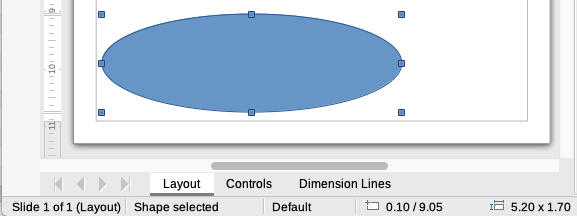
To help in the positioning and adjustment of objects, Draw has a zoom function that reduces or enlarges the screen display of the current drawing. For example, zoom in when placing objects onto your drawing for greater accuracy in positioning, or zoom out to see the complete drawing. You can control zooming using the Status Bar, Zoom & View Layout dialog, or Zoom toolbar. For more information on using zoom, see the Draw Guide.
To move an object (or a group of objects), select it and then click within the object borders and hold down the left mouse button while dragging the mouse. During movement, a ghost image of the object appears to help with repositioning ( Figure 25). To locate the object at its new location, release the mouse button.
Figure 25: Moving objects
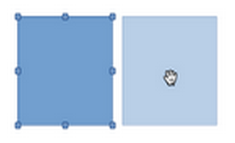
To change the size of a selected object (or a group of selected objects), move the mouse cursor to one of the selection handles. The cursor will change shape to indicate the direction of movement for that selection handle. As you change the size of the object, a ghosted outline of the object appears ( Figure 26). When you have reached the desired size of the object, release the mouse button.
The results depend on which selection handle you use. To resize an object along one axis, use a side, top, or bottom handle. To resize along both axes, use a corner handle.
Note
If you press the Shift key while resizing an object, the change in size will be carried out symmetrically on the two axes so that the aspect ratio of the object remains the same. This Shift key behavior works on all selection handles.
Figure 26: Adjusting object size
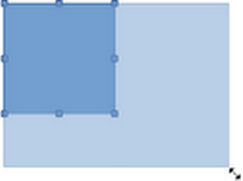
To rotate or slant an object (or a group of objects), select an object and switch to rotation mode using one of the following methods:
Right-click on the object and select Transformations > Rotate from the context menu.
Click on the small downward triangle ▼ on the right of the tool icon for Transformations on the Standard or Line & Filling toolbar and select Rotate.
The selection handles change shape and color ( Figure 27) and a center of rotation appears in the center of the object. As you move the mouse cursor over the handles, the cursor changes shape to indicate the type of movement.
Figure 27: Rotating an object
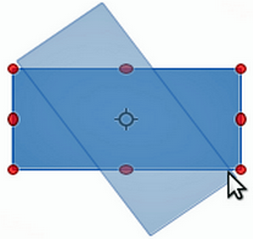
1) Click and hold the mouse button over a corner selection handle, then move the cursor to rotate the object. A ghost image of the object being rotated appears and the current angle of rotation is shown in the Status Bar.
2) When the object is at the desired rotation angle, release the mouse button.
3) To change the angle of rotation, click on the rotation point and drag it to another position. This position can be outside of the object.
Note
Press the Shift key while rotating or slanting an object and the movement is restricted to 15° of movement.
1) Click and hold the mouse button over a selection handle at the top, bottom, left side, or right side of an object.
2) Drag the selection handle to slant the object ( Figure 28). A ghost image of the object being slanted appears and the current slant angle is shown in the Status Bar. The axis used for slanting an object is fixed to the edge of the object directly opposite the selection handle being used to slant the object.
3) When the object is at the desired slant angle, release the mouse button.
Figure 28: Slanting an object
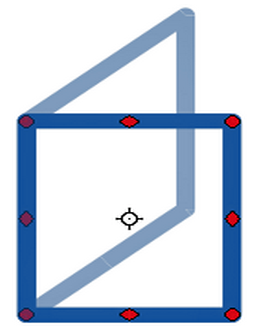
Select an object so that the selection handles are displayed and flip the object vertically or horizontally using one of the following methods:
Right-click on the object and select Flip > Vertically or Horizontally from the context menu.
Go to Shape > Flip > Vertically or Horizontally on the Menu bar.
Click on Vertically or Horizontally tool on the Line and Filling toolbar.
Use Flip Vertically or Flip Horizontally tool in the Position and Size section on the Properties deck of the Sidebar.
However, the Flip tool on the Transformations toolbar ( Figure 29) provides greater control over the flipping process. Use the Flip tool to change the position and angle that the object flips over, see the Draw Guide for more information.
Figure 29: Transformation toolbar

Three tools on the Transformations toolbar ( Figure 29) let you drag the corners and edges of an object to distort an object.
Distort – distorts an object in perspective.
Set in Circle (perspective) – creates a pseudo 3D effect.
Set to Circle (slant) – creates a pseudo 3D effect. Despite the (slant) in the name of this tool, it operates differently to the slanting created by rotation.
In all three cases you are initially asked if you want to transform the object to a curve. This is a necessary first step, so click Yes. Then you can move the object handles to produce the desired effect. See the Draw Guide for more information on how to distort an object.
You can control transparency gradients in the same manner as color gradients. Both types of gradient can be used together. With a transparency gradient, the direction and degree of the object fill color changes from opaque to transparent. In a color gradient, the fill changes from one color to another, but the degree of transparency remains the same. An example of a dynamic gradient is shown in Figure 30.
Two icons are present on the Transformations toolbar ( Figure 29) to dynamically control transparency and color gradients – Interactive Transparency and Interactive Gradient. See the Draw Guide for more information on how to create transparencies and gradients in an object.
Figure 30: Dynamic gradient example
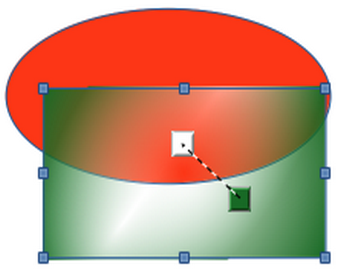
Duplication makes copies of an object while applying a set of changes such as color or rotation to the duplicates that are created. An example of duplication is shown in Figure 31. For more information on duplication, see the Draw Guide.
1) Click on an object or group of objects and open the Duplicate dialog ( Figure 32) using one of the following methods:
Go to Edit > Duplicate on the Menu bar.
Go to Shape > Duplicate on the Menu bar.
Use the keyboard shortcut Shift+F3.
2) Select the required number of copies, placement, enlargement, and colors from the options available.
3) Click OK to duplicate the object and close the Duplicate dialog.
Figure 31: Duplication example
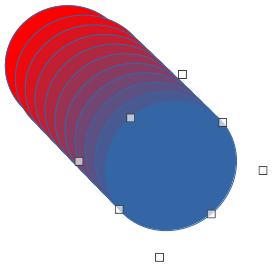
Figure 32: Duplicate dialog
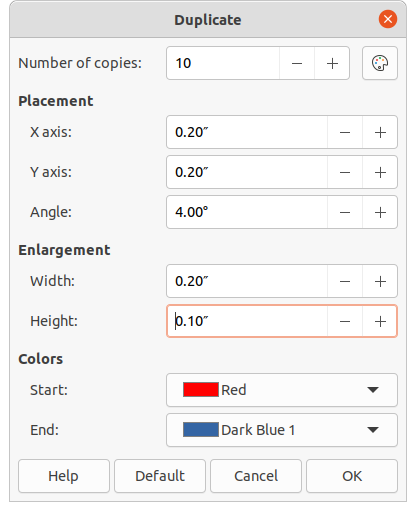
Cross-fading transforms one object shape to another object shape. Cross-fading only works when two objects are selected.
1) Select two differently shaped objects.
2) Go to Shape > Cross-fading on the Menu bar to open the Cross-fading dialog ( Figure 33).
3) In Increments to determine the number of shapes between the two objects.
4) Select Cross-fading attributes to apply a gradual change of line and fill properties between the two objects.
5) Select Same orientation to apply a smooth transition between the two objects.
6) Click OK to carry out the cross-fading and close the Cross-fading dialog.
The result is a new group of objects with the first object selected as the start object and the second object selected as the end object. For example, when the options in the Cross-fading dialog are applied to a rectangle and a diamond, the cross-fading produces the result shown in Figure 34.
Figure 33: Cross-fading dialog
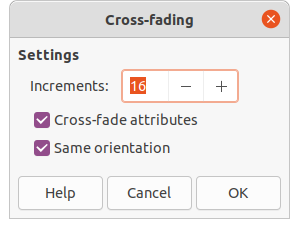
Figure 34: Cross-fading example of two objects
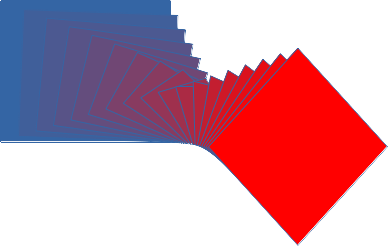
Using Draw, you can group or combine objects together allowing you to treat multiple objects as one object, or merge objects to form a new shape. For more information on grouping and combining objects, see the Draw Guide.
Grouping of objects is similar to putting objects into a container. You can move the objects as a group and apply global changes to the objects within the group. A group can always be undone (ungroup). Objects that make up a group can always be manipulated separately and retain their own individual properties.
Combining objects is a permanent merging of objects creating a new object. The original objects are no longer available as individual entities and cannot be edited as individual objects. Any editing of a combined object affects all the objects that were used when combination was carried out.
A temporary grouping is when several objects are selected using one of the following methods:
While holding down the Shift key, click on each object with the cursor to select it for the temporary group.
Using the mouse, click and drag a rectangle (also known as a marquee) around the objects for the temporary group.
Any changes to object parameters you carry out are applied to all of the objects within the temporary group. For example, you can rotate a temporary group of objects in its entirety.
To cancel a temporary grouping of objects simply click outside of the selection handles displayed around the objects.
A permanent grouping of objects can be created after selecting objects using one of the following methods:
Go to Shape > Group > Group on the Menu bar.
Right-click on the selected objects and select Group from the context menu.
Use the keyboard shortcut Ctrl+Shift+G.
When you deselect your selection, the objects remain grouped together. Any editing operations carried out on the group are applied to all objects within the group. If you click on one object in the group, the whole group is selected.
You can edit an individual object in a group without ungrouping or breaking the group. After selecting the group, use one of the following methods to enter the group:
Go to Shape > Group > Enter Group on the Menu bar.
Right-click on the selected group and select Enter Group from the context menu.
Use the keyboard shortcut F3.
Double-click on the selected group.
When you have finished editing an individual object within a group, use one of the following methods to exit the group:
Go to Shape > Group > Exit Group on the Menu bar.
Right-click and select Exit Group from the context menu.
Use the keyboard shortcut Shift+F3.
To ungroup or break apart a permanent group of objects, use one of the following methods after selecting the group:
Go to Shape > Group > Ungroup on the Menu bar.
Right-click and select Ungroup from the context menu.
Use the keyboard shortcut Ctrl+Alt+Shift+G.
You can create a group of groups, which are more commonly known as nested groups. When you create nested groups, Draw retains the individual group hierarchy and remembers the order in which groups were selected. That is, the last individual group selected will be on top of all the other groups within a nested group.
Ungrouping and entering a nested group works in the same way as for individual groups.
Combining objects is a permanent merging of objects, creating a new object. The original objects are no longer available as individual entities and cannot be edited as individual objects. Any editing of a combined object affects all the objects that were used when combination was carried out. For more information on combining objects, see the Draw Guide.
After selecting the objects that you want to combine, use one of the following methods to create a new object:
Go to Shape > Combine on the Menu bar.
Right-click on the objects and select Shapes > Combine from the context menu.
Use the keyboard shortcut Ctrl+Shift+K.
After selecting several objects, the Merge, Subtract, and Intersect functions become available. These functions are similar to combining objects, but allow you to create a differently shaped object from the selected objects. The shape of the object depends on which function you use. See the Draw Guide for more information on how to use these functions.
In Draw you can arrange, align, and distribute selected objects in relation to each other:
Arrange the position of an object by moving it either forward or backward in relation to the order of objects.
Align objects with respect to each other using Left, Centered, or Right for horizontal alignment and Top, Center, or Bottom for vertical alignment.
Distribute objects so that the space between each of the objects is the same.
See the Draw Guide for more information on arranging and aligning objects.
Draw contains a number of functions for editing images (also called pictures, raster graphics, or bitmaps). This includes the import and export of images, and conversion from one image format to another. For more information on working with images, see Chapter 11, Images and Graphics in this guide and the Draw Guide.
Draw includes a large range of filters so that it can read and display several image file formats. It also includes several tools for working with images, but does not have the same functionality as specialized programs like GIMP or Adobe Photoshop.
You can add images from several sources:
Directly from a scanner (Insert > Media > Scan on the Menu bar).
Created by another program, for example photographs from a digital camera (Insert > Image on the Menu bar).
The LibreOffice Gallery; see Chapter 11, Images and Graphics.
Draw saves images as drawings in the Open Document Format (ODG). To save an image or the entire Draw file in another format, go to File > Export on the Menu bar and select a format from the drop-down list. The image formats that Draw can export in and save to are listed in Appendix B, Open Source, Open Standards, OpenDocument in this guide.
You can also export Draw files in HTML, XHTML, or PDF format from LibreOffice. For more information, see Chapter 10, Printing, Exporting, Emailing, and Signing.
HTML export uses a conversion wizard that creates as many web pages as there are pages in your Draw document. You can optionally choose to display pages in frames with a navigator and set an index page. For more information, see Chapter 12, Creating HTML Files.
Although Draw does not match the functionality of specialized drawing or image editing programs, it is capable of producing and editing very good 3D drawings. For more information, see the Draw Guide.
You can quickly create a 3D object in Draw using one of the following methods:
Select a 3D shape from the 3D Objects section in the Shapes deck on the Sidebar.
Right-click on a 2D object and select Convert > To 3D or To 3D Rotation Object from the context menu.
Right-click on a 2D object and select Format > 3D Effects on the Menu bar.
Using layers when creating complex drawings makes a drawing easier to navigate and edit. Placing a simpler drawing that is part of a complex drawing into its own layer makes editing easier. Any area of a layer that does not contain a drawing object is transparent and does not obscure any part of a complex drawing. You can add any number of layers to a drawing document. For more information on layers, see the Draw Guide.
A drawing in LibreOffice contains three default layers that you cannot delete or rename:
Layout – is the default Workspace where objects are normally placed when a drawing is created.
Controls – used for form controls that have been assigned an action. Objects on this layer are always in front of objects on other layers.
Dimension Lines – is where the dimension lines are drawn. By switching the layer to show or hide, you can easily switch dimension lines on and off.
A layer can be set to one or all of the following attributes:
Visible or hidden.
Printable or not printable.
Locked or unlocked.
To quickly toggle the attributes for a selected layer, use the following keyboard shortcuts:
Shift+click – toggle between a layer being visible or hidden.
Ctrl+click – toggle between a layer being locked or unlocked.
Ctrl+Shift+click – toggle between a layer being printed or not printed.
To add a layer to a drawing:
1) Use one of the following methods to open the Insert Layer dialog ( Figure 35):
Go to Insert > Layer on the Menu bar.
Right click on the layer tabs at the bottom of the Workspace and select Insert Layer from the context menu.
Figure 35: Insert Layer dialog
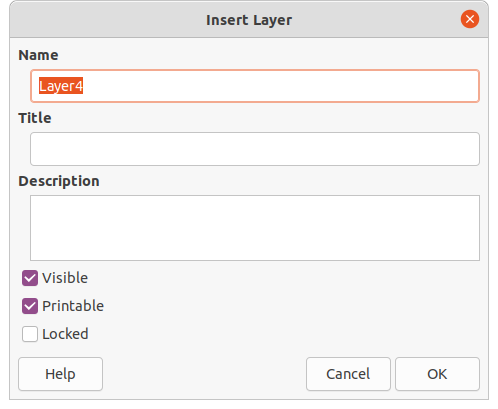
2) Enter a meaningful Name, Title and Description for the new layer in the text boxes.
3) Select Visible if you want the layer to be visible in your drawing. When Visible is not selected, the layer is hidden and its name in the layer tab changes color to blue.
4) Select Printable if you want the layer to be printed when you print your drawing. Not printing is useful if you want use a draft layer for guides or annotations that you use in making the drawing, but do not want to appear in the final output. The name of a layer is underlined in the layer tab bar when the Printable option is turned off.
5) Select Locked to prevent any objects on this layer from deletion, editing, or moving. No additional objects can be added to a locked layer. Locking a layer is useful, for example, when a base plan is to be protected while adding a new layer with other details. The name of a locked layer is written in Italics in the layer tab bar.
6) Click OK to create the new layer and close the Insert Layer dialog. A new layer automatically becomes active when added to a drawing.
Note
Layers are added to the drawing in the order that they were inserted. The layer order cannot be changed.
1) To modify a layer use one of the following methods and open the Modify Layers dialog. The Modify Layers dialog is similar in layout and options to the Insert Layers dialog ( Figure 35).
Right-click on the name tab of the layer and select Modify Layer from the context menu.
Double-click on the layer tab.
Go to Format > Layer on the Menu bar.
2) Make your changes to the layer, then click OK to save the changes and close the Modify Layers dialog.
Note
For a more detailed description of the options available for color palettes and custom colors, as well as more information on the difference between the CMYK and RGB color schemes, refer to the Draw Guide.
Figure 36: Color Palette
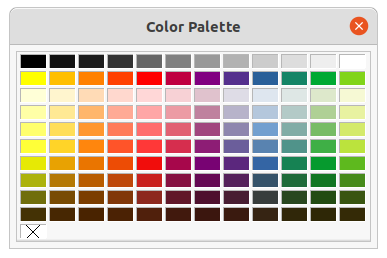
To display the Color Palette that is currently in use ( Figure 36), go to View > Color Bar on the Menu bar. To close the Color Palette, go to View on the Menu bar and deselect Color Bar.
Using the Color Palette, you can rapidly choose the color of the area or background, and lines of selected objects in your drawing.
Left click on a color to change the color of the area or background of a selected object.
Right click on a color to change the color of the lines in a selected object.
Left-click or right-click on the box with the X at the bottom left of the Color Palette to select no color for the area or lines of a selected object.
In the Area and Line sections in Properties deck on the Sidebar ( Figure 37), you can change the color of the area or line of a selected object and the color palette as follows:
1) Select an object in your drawing.
2) Click on Properties on the Sidebar to open the Properties deck.
3) Open the Area and/or Line sections by clicking on the down pointing symbol ˅ on the section title bar.
Figure 37: Sidebar Area and Line color
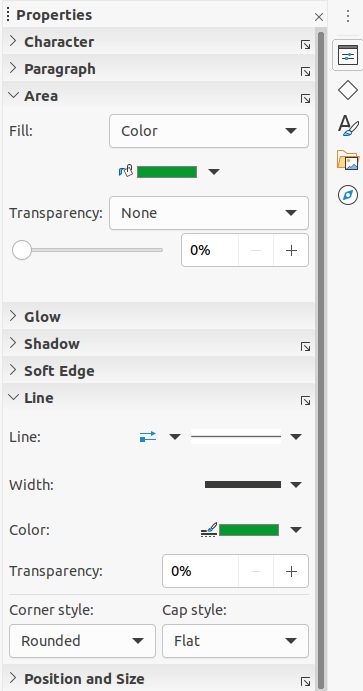
4) Change the color of an area in the Area section as follows:
a) Select Color from the Fill drop down list.
b) Click on the down pointing symbol ▼ next to the Fill Color box to open the color palette.
c) Click on a color to change the area color.
d) To change the color palette, click on the down pointing symbol ▼ at the top of the color palette and select a color palette from the drop down list.
5) Change the color of a line in the Line section as follows:
a) Click on the down pointing symbol ▼ next to the Line Color box to open the color palette.
b) Click on a color to change the area color.
c) To change the color palette, click on the down pointing symbol ▼ at the top of the color palette and select a color palette from the drop-down list.
The Line and Filling and Drawing toolbars have the same two tools that can be used to change the color of an area (fill) or line – Fill Color and Line Color. These two tools are used in the same way as changing colors using the Area and Line sections on the Sidebar. See “Sidebar color” above for more information.
You can insert comments into a drawing in a similar process to the one used in Writer and Calc.
Before using comments, you have to go to Tools > Options > LibreOffice > User Data and enter your name and initials. Your name and initials will then appear in the comment marker and in the Author field of the comment.
If more than one person edits the document, each author is automatically allocated a different background color.
1) Go to View > Comments on the Menu bar to show or hide the comment markers.
2) Go to Insert > Comment on the Menu bar. A small box containing your initials appears in the upper left-hand corner of your drawing with a larger text box beside it, as shown in Figure 38. Draw automatically adds your name and the date at the bottom of this text box.
3) Type or paste your comment into the text box.
4) If necessary, move the small comment markers to a different position on the drawing. Normally, the comment marker is placed on or near the object you refer to in the comment.
5) Apply basic formatting to the text by selecting it, right-clicking, and choosing from the context menu. On this menu, you can also delete the current comment, all the comments from the same author, or all the comments in the document.
Figure 38: Inserting comments
